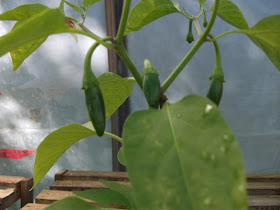Cilantro is one of the world's most widely used herbs. It is commonly used in Chinese and Indian cuisines; those two countries alone account for 36% of the world's population. And, of course, there is Latin food (not sure if gourmets would consider Tex-Mex to be Latin cuisine?).
I never liked cilantro when I was younger. In my mid-twenties I lived in the Kitsilano area of Vancouver, just a few blocks from Las Margaritas Mexican Restaurant on 4th Avenue. A friend absolutely LOVED this restaurant, so every time she came for a visit that is where we went. They served freshly made tortilla chips and salsa. The salsa was heavily laden with cilantro and I had a hard time eating it. I know a lot of people find cilantro has a soapy smell and so it was for me. I suspect it was after I fell in love with Indian food that my tastes changed, although I still find the roots smell soapy.
Cilantro is reasonably easy to grow, but it has its challenges. Unless you have grown cilantro before, you may not realize that when you purchase a bunch of cilantro at the store, you are actually buying a dozen or so entire "plants"! Same with parsley - if you cook with it a lot, you need quite a lot of plants, so it is best to start seeds every few weeks. The challenge then becomes using it. If you have many plants, and don't keep up with them, they will bolt or "go to seed". If I'm not cooking with it enough, I'll just clip some off anyway to avoid bolting and encourage new growth.
The seeds, of course, are referred to as coriander. At some point, I intentionally allow the plants to bolt so I can harvest the seeds. Dry the seeds, then store in a jar for year-round use.
Cilantro-Lime Black Beans:
3/4 cup onion, medium dice
3 cloves garlic, minced
19 oz can black beans, rinsed and drained
1/4 cup cilantro leaves and stems, chopped
Juice of 2 limes
Salt
Saute the onions and garlic. Add black beans. Cook for about 20 minutes until beans begin to soften, adding a tablespoon or two of water as needed. For texture, I used an immersion blender at this point on about half the mixture. Stir in the cilantro and lime, and season to taste. Continue cooking another 5-10 minutes to ensure flavours are well blended.
 This makes a great vegetarian filling for fajitas, or just as a side dish. It can also be served cold or warm as a dip - just blend the entire mixture, adding a bit of water to create a smoother texture (or more lime juice for a tart dip).
This makes a great vegetarian filling for fajitas, or just as a side dish. It can also be served cold or warm as a dip - just blend the entire mixture, adding a bit of water to create a smoother texture (or more lime juice for a tart dip).For this fajita meal, I also made a fresh salsa using the same general recipe as I used for the Grilled Tilapia Tacos but this time I added in some hot peppers.
I forgot to buy jalapenos, but managed to scrounge a baby jalapeno and a Hungarian Hot Wax pepper off plants in the greenhouse.
And Happy Father's Day!




No comments:
Post a Comment